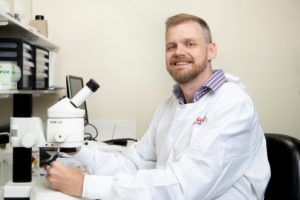Scientists have visualised and investigated a key molecular pathway that could one day help treat inflammation, diabetes, cancer, infectious diseases and potentially even COVID-19.
The international collaboration, featuring Griffith University’s Institute for Glycomics researchers, isolated and studied the MyD88 protein molecule and found the missing link between immune cell receptors and the body’s inflammation response.
Lead researcher Dr Thomas Ve from the Institute for Glycomics said the research was achieved thanks to advancements in molecular visualisation and analysis technology.

Dr Thomas Ve
“Just a few years ago, ‘conventional’ techniques such as X-ray crystallography weren’t able to study these types of proteins,” Dr Ve said.
“We’ve had to develop and use some cutting-edge technology, in this case microcrystal electron diffraction and X-ray free electron lasers.
“This is one of the first times microcrystal electron diffraction has been used to determine a new protein structure in this way. And this was one of the first comparisons of these emerging structural biology techniques.
“In the end, both of these incredible technologies gave us the world’s first clear image of this critical inflammatory target.”
Co-lead researcher Professor Bostjan Kobe from the University of Queensland said he and his colleagues had noticed a gap in understanding what activated inflammation within the body.
“Our immune system triggers inflammation as a protective measure when pathogens or bacteria enter our bodies, but sometimes this defence goes awry and can worsen how our body copes with the disease,” Professor Kobe said.
“We knew that signals sent from the receptors on the surface of immune cells led to inflammation in the body but didn’t understand how this occurred at a molecular level.
“Now we’ve scrutinised and visualised an incredibly important protein called MyD88. This is a key signalling molecule in immunity pathways; its job is to pass a message from the immune cell receptors for the body to trigger an immune response.
“While immunity is clearly needed to fight against pathogens, sometimes the immune system can trigger falsely or hyperactivate an inflammatory response even once the pathogen is gone.”
By better understanding how to block this pathway, researchers could be able to treat diseases like rheumatoid arthritis, diabetes, cancer and even COVID-19.
Professor Mark von Itzstein AO, Director of the Institute for Glycomics said the work was an outstanding example of how international collaborations could produce major breakthroughs in biomedical research.
“I am very excited to see the next developments in this research, as it presents outstanding opportunity in new disease treatment discovery.”
The research has been published in Nature Communications.
The collaborative study was conducted by the research groups of Dr Thomas Ve, Professor Bostjan Kobe, Dr Hongyi Xu (Stockholm University), Dr Connie Darmanin (La Trobe University), Kate Stacey (UQ) and Yann Gambin (UNSW).


